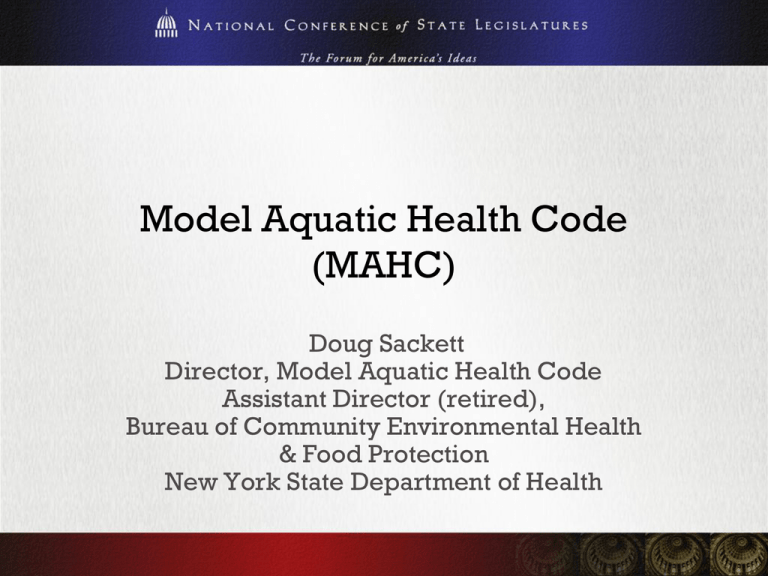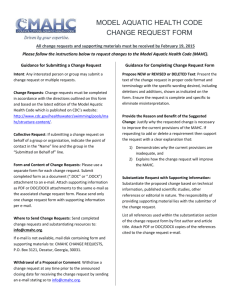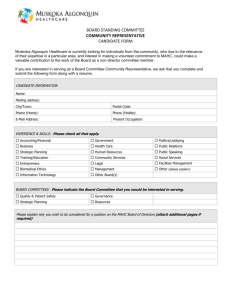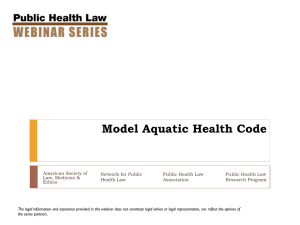Model Aquatic Health Code (MAHC)
advertisement

Model Aquatic Health Code (MAHC) Doug Sackett Director, Model Aquatic Health Code Assistant Director (retired), Bureau of Community Environmental Health & Food Protection New York State Department of Health State and Local Perspective: Pool Program Challenges Pool design and construction advances rapidly Many codes are years out of date (up to 30 years old) Disparate regulations at state and/or local level Disparate across jurisdictional lines • Between states • Between localities Some states don’t have a pool code so codes are at the county or city level State and Local Perspective: Pool Program Challenges Huge resource investment by health departments to update • Localities must “re-invent the wheel” Metro Atlanta, GA • Multi-county pool code update effort • 3 years, >2000 hours committee time, uncounted hours of individual county staff time • Best product achieved with limited resources • Code does not have MAHC depth of detail nor science basis due to lack of national expertise in process State and Local Perspective: Pool Program Challenges Health departments unable to rapidly respond to new and emerging issues • Health: chemicals, new pathogens, injuries and drowning, indoor air quality • Design: new features, designs, and technology developed by industry that are no longer covered in older codes Shrinking resources for pool programs • Staff and funding cuts • Elimination of pool programs State and Local Perspective: The MAHC Can Benefit Pool Programs Improved consistency across country • Learning lessons in one state can be used to update model code for entire country • Indoor ventilation, Cryptosporidium control (chlorinetolerant), operator/lifeguard training A progressive health department can more easily adopt language if it is a national science - and best practices – based model code • Won’t be accused of “being the only health department doing so” State and Local Perspective: The MAHC Can Benefit Pool Programs Reduced resource requirements • Jurisdictions no longer need to “re-invent the wheel” • Public-private partnership at national level can: o Ensures public health and aquatics industry works together on the mutual goal to reduce disease and injury to share latest national-level expertise o Ensures regular updates and improvements that keep up with latest public health and technological advancements State and Local Perspective: The MAHC Can Benefit Pool Programs Improved partnerships • Improved public relations if health department uses code language developed with industry input • Improved product if MAHC involves top industry and public health experts that are not available for every state or local revision • Improved public health-industry partnerships likely to improve regulatory approvals and inspections State and Local Perspective: The MAHC Will Offer “Value Added” Improved guidance and understanding • The MAHC includes an extensive Annex and Reference List that gives the science and supporting rationale behind the model code language Improved tools • The MAHC offers templates for sample inspection forms, incident reports, standard operating procedures, checklists, etc. that reduce the work burden at the state and local level State and Local Perspective: The MAHC Will Offer “Value Added” Consistency in inspections and data collection • Data can be used for evaluating pool programs, informing decision making, and driving resource allocation • Data can show program impact and importance Positive Impacts at local and regional health • Improved pool operation • Environmental health officials can focus on job rather “reinventing” pool codes • Improved health: decreased injuries and disease State and Local Perspective: The MAHC Will Offer “Value Added” Create a research agenda • Revision of the MAHC is pointing out critical areas needing research to improve industry operation • Funding can be done as a consortia of public and private funding at national level rather than by individual localities who cannot afford it • National needs can be prioritized and addressed for more efficient resource use






